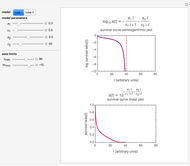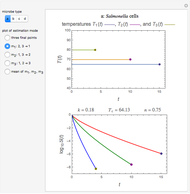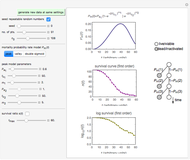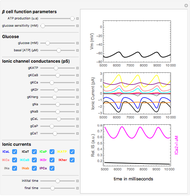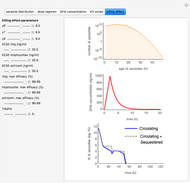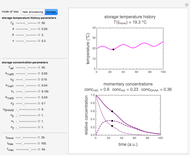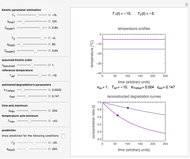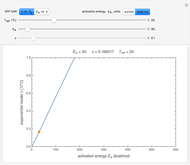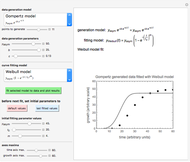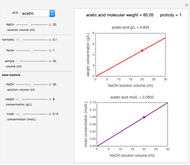Degrees of Microbial Injury and Survival

Requires a Wolfram Notebook System
Interact on desktop, mobile and cloud with the free Wolfram Player or other Wolfram Language products.
A microbial survival curve is a plot of the number or fraction of the survivors as a function of their exposure time to a hostile environment or lethal agent. It is traditionally determined by counting the survivors' colonies after incubation under optimal conditions to maximize recovery. Simultaneous incubation under stressful conditions only allows intact microbes to grow, and the difference is used to calculate the number of injured cells or spores. However, one can also incubate the survivors under several intermediate stress levels in order to assess different degrees of injury. The principle is demonstrated with simulated original survival curves following the Weibullian model, supplemented by three curves representing the fractions of intact, slightly injured, and gravely injured survivors.
Contributed by: Mark D. Normand and Micha Peleg (September 2014)
Open content licensed under CC BY-NC-SA
Snapshots
Details
Snapshot 1: survival and injury curves produced with the Weibullian model with shape factor 
Snapshot 2: survival and injury curves produced with the log-linear, first-order kinetic model that corresponds to the Weibullian model with a shape factor 
Snapshot 3: survival and injury curves produced with the Weibullian model with shape factor  ("tailing")
("tailing")
Traditionally, the survival curves of microbial cells and bacterial spores exposed to a hostile environment or lethal agent (e.g. heat, ultra-high hydrostatic pressure, or chemical disinfectant) are determined by counting the survivors' colonies after incubation under optimal conditions with respect to temperature, pH, nutrients, and so on. Under such conditions, injured cells or spores are likely to be counted as survivors. If the recovery is made after incubation under stressful conditions, then it is likely that only intact cells or spores will produce colonies, and hence the difference is an indicator of the number or fraction of the injured cells. It is possible, however, to incubate the survivors under several levels of stress in order to reveal the numbers of intact survivors and those at various levels of injury. This has actually been done, albeit infrequently.
In this Demonstration, the principle is demonstrated by simulating regular survival curves accompanied by curves representing the intact, slightly injured, and gravely injured survivors. The curves, shown on linear and semilogarithmic coordinates, are generated with the Weibullian model  , where
, where  is the survival ratio (that is,
is the survival ratio (that is,  , where
, where  is the count after exposure time
is the count after exposure time  and
and  is the initial number),
is the initial number),  is a characteristic time ("scale factor"), and
is a characteristic time ("scale factor"), and  is the shape factor. Where
is the shape factor. Where  , the semilogarithmic curve has downward concavity, and where
, the semilogarithmic curve has downward concavity, and where  , it has upward concavity ("tailing"). The log-linear (first-order kinetics) model is a special case of the model where
, it has upward concavity ("tailing"). The log-linear (first-order kinetics) model is a special case of the model where  .
.
To create a set of four curves, select their Weibullian model's parameters (the  and
and  ), the time axis maximum, and the
), the time axis maximum, and the  axis minimum with the sliders. The four curves will then be displayed, in different colors, on linear (top plot) and semilogarithmic (bottom plot) coordinates. By moving the time slider, the vertical gray line on the top plot will display the numerical values of the corresponding percentage of the cells or spores in each of the following states: intact, slightly injured, and gravely injured (green, blue, and purple, respectively), as well as the total momentary survival (red). The vertical gray line on the bottom plot displays the corresponding numerical values of their fraction expressed as its base-10 logarithm. The displayed numeric values above both plots are rounded to the first digit after the decimal point.
axis minimum with the sliders. The four curves will then be displayed, in different colors, on linear (top plot) and semilogarithmic (bottom plot) coordinates. By moving the time slider, the vertical gray line on the top plot will display the numerical values of the corresponding percentage of the cells or spores in each of the following states: intact, slightly injured, and gravely injured (green, blue, and purple, respectively), as well as the total momentary survival (red). The vertical gray line on the bottom plot displays the corresponding numerical values of their fraction expressed as its base-10 logarithm. The displayed numeric values above both plots are rounded to the first digit after the decimal point.
The objective of the Demonstration is only to demonstrate the principle of separating the degrees of injury. Hence, no attempt has been made to match the survival patterns of specific organisms or spores or to account for all possible separable injury levels.
Permanent Citation






